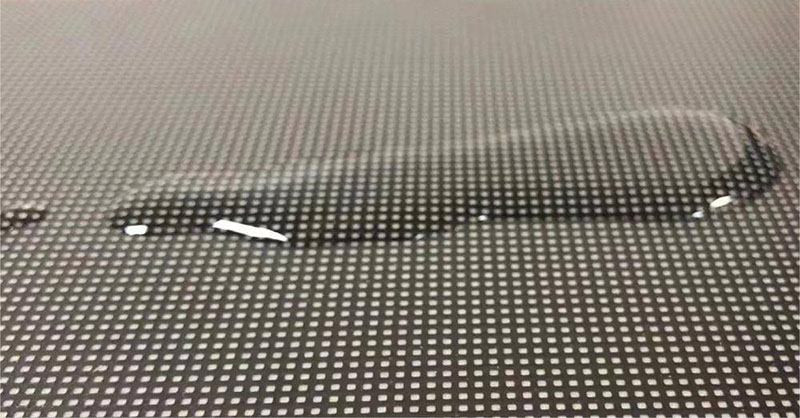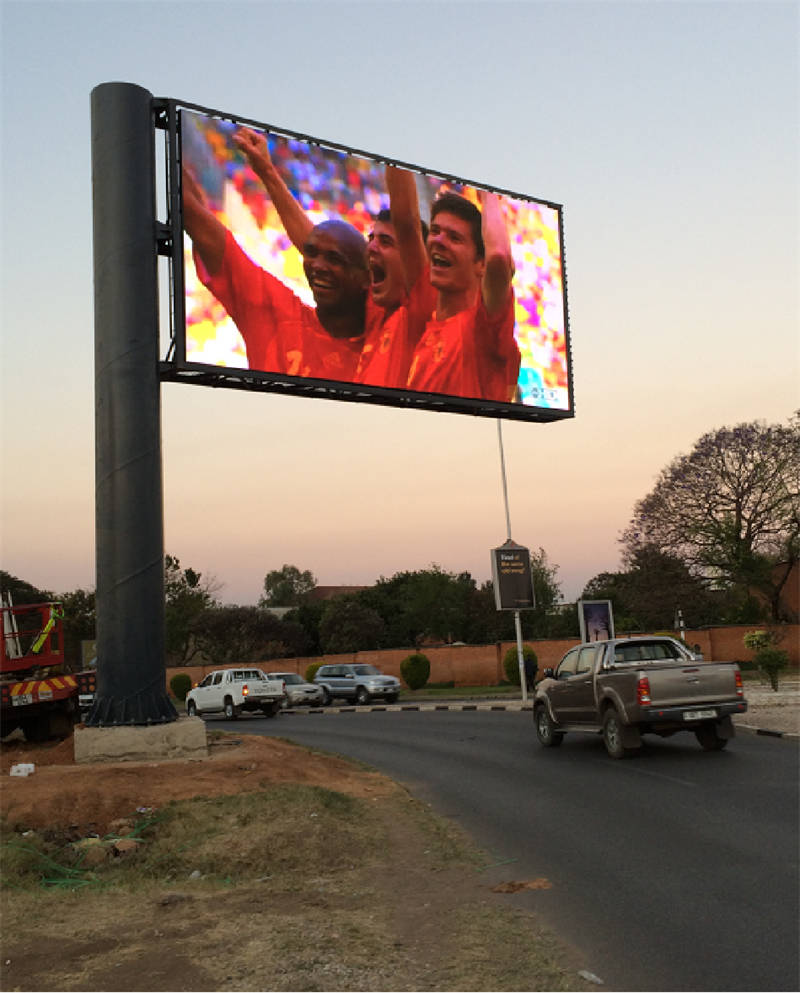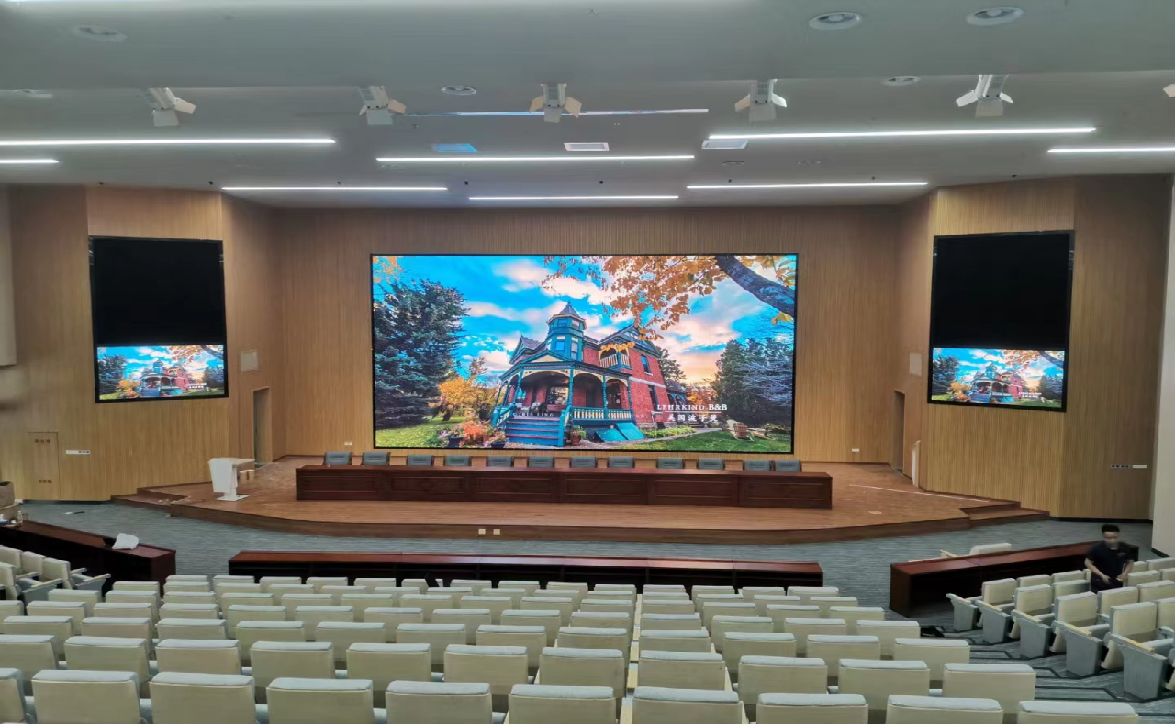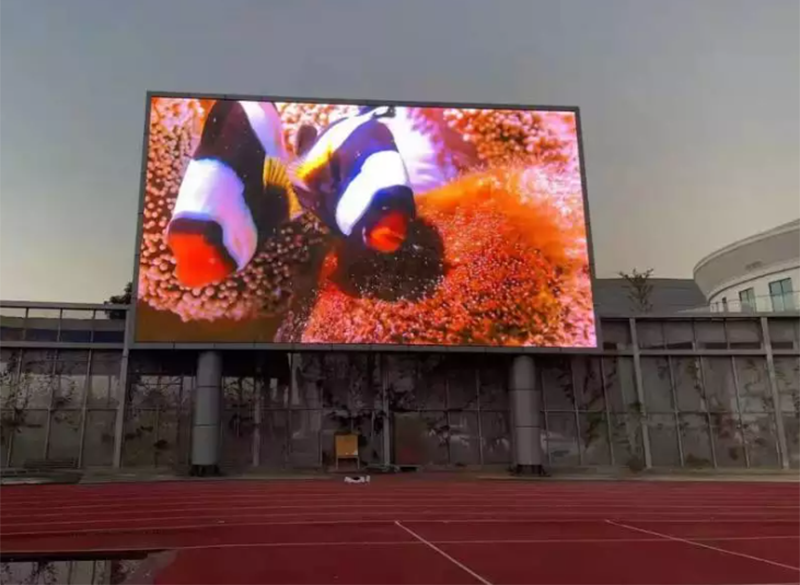With the continuous advancement of technology, radio and television stations have higher and higher requirements for studio background display systems. In recent years, small-pitch LED display screens have gradually replaced traditional LCD video walls due to their advantages such as seamless splicing, high brightness, and high refresh rate.
They have become the preferred solution for studio background display systems of radio and television stations. SightLED will introduce the application of small-pitch LED screens in depth.
Table of Contents
ToggleWhy do television stations choose small-pitch LED screens instead of LCD video walls?

When you choose a display system for a radio and television station, you may face many considerations, including display effects, technical performance, and application. However, small-pitch LED screens have significant advantages over traditional LCD video walls in these aspects.
Reason 1: Seamless splicing and picture integrity
The traditional LCD video wall is made up of multiple screens spliced together. Limited by the physical frame, there is an obvious black border after splicing, which destroys the integrity of the picture. When shooting panoramic shots, and the sense of separation at the seams will seriously affect the visual effect.
Small-pitch LED screens use modular splicing technology, and the minimum seam can be controlled within 0.1mm, which can almost achieve a truly “borderless” display. For example, in the case of the main screen and the secondary screen form SightLED, the picture continuity reached the movie level, which perfectly meets the large-scale stage beauty requirements of variety shows.
Reason 2: High brightness and color consistency
Due to the complex lighting environment of the studio, the LCD screen is not bright enough (usually only 300-500nit). It is easy to reflect or whiten the picture under strong light. The brightness of the small-pitch LED screen can reach 1200-6000nit (such as SIgtLED system supports 1000nit brightness), and supports HDR display.
Even under strong light indoors, the color can be accurately restored. In addition, since each pixel of the LED screen emits light independently, the “four-corner dark area” problem caused by uneven LCD backlight is avoided, further improving the uniformity and consistency of the picture.
Reason 3: Dynamic performance and shooting adaptability
The refresh rate of LED screens is generally higher than that of LCDs. For example, our LED screen system can reach 5000Hz, and there is no scan line interference when shooting with a 1/8000s shutter. Its microsecond response speed completely eliminates dynamic smear, making the picture smoother and clearer.
In addition, the LED screen can accurately match the studio lighting by adjusting the color temperature (supporting 2700K-10000K adjustment), which can further improve the color reproduction and consistency of the shooting picture.
Reason 4: Flexible layout and space utilization
Traditional LCD walls cannot be moved after installation, while modular LED screens support multi-form combinations. You can quickly reorganize according to different scene requirements.
For example, the SightLED secondary screen equipped with universal wheels. Through rapid reorganization, the same system can meet the needs of different scenes such as news, interviews, and evening parties, and the space utilization rate is increased by more than 40%. In addition, we use ultra-thin LED screens cabinet (usually <100mm) design. Compared with LCD walls, it can save 30% of the depth space, further improving the space utilization of the studio.
What types of small-pitch LED screens are suitable for radio and television stations?
When you choose a broadcast small-pitch LED screen, you need to choose the right type according to the specific needs. There are three main types of traditional SMD small-pitch screens, GOB small-pitch screens and COB small-pitch screens on the market.
Traditional SMD small-pitch screens
The traditional SMD small-pitch screen pitch range is usually P0.9-P3.0. This type of small-pitch screen technology is mature, with a market share of more than 70%, convenient maintenance, and a single module can be quickly replaced. However, traditional SMD small-pitch screens also have some limitations, such as:
- Weak protection (exposed lamp beads)
- High difficulty in flatness control, etc.
- Suitable for fixed installation
- Medium and large studios.
GOB small-pitch screens

With the improvement of technology. GOB small-pitch screens add a transparent potting glue layer on the basis of SMD. They can further improve anti-collision, moisture-proof and anti-static performance. Its surface hardness can reach 6H, which is particularly suitable for the secondary screen scene with frequent movement.
For example, if SightLED the secondary screen adopts GOB technology in a case, the damage rate of lamp beads caused by prop collision can be reduced (the theoretical failure rate is reduced by 50%). However, it should be noted that the transmittance of GOB small-pitch screen will be reduced by about 8%, and it needs to be used with lamp beads with higher brightness.
COB small-pitch screen

The COB small-pitch screen integrates LED chips directly onto the PCB through chip-level packaging to achieve micron-level pixel spacing (up to P0.4). This type of small-pitch screen has ultra-high protection (no exposed components on the surface), ultra-wide viewing angle (170°+), low blue light and other characteristics. Although the GOB LED display cost per square meter is 30%-50% higher than SMD, the long-term maintenance cost is lower, which is an ideal choice for 4K/8K ultra-high-definition production.
Studio LED large screen design ideas and practical experience

When you design a studio LED large screen, you need to comprehensively consider multiple aspects such as system architecture design, key technical parameter selection, and key design experience. Below we will take a 400㎡ studio as an example for a detailed introduction.
1. System architecture design
A 400㎡ studio LED display system adopts a distributed architecture, which can improve stability and reliability.
Core equipment: Dual backup BVP6000 video processor, supporting 6-channel 4K signal windowing to ensure signal stability and diversity.
Transmission system: Dual-link optical fiber transmission, the main and standby switching time is less than 1s, ensuring the real-time and continuity of the signal.
Power management: Intelligent PDU power supply, supporting remote monitoring and hierarchical power-on, improving the intelligence and safety of power management.
Cooling solution: Silent fanless design, noise less than 35dB, ensuring a quiet environment in the studio.
Key technical parameter selection
When we select the key technical parameters of the LED large screen, you can refer to the following key technical parameters, recommended range and design points.
Pixel Pitch: The solution selects P2.5 LED display. We recommended pixel pith range is P1.2-P3.0. However, P2.5 choice balance the viewing distance and resolution requirements.
Refresh rate: The solution selected a refresh rate of 3840Hz. We recommended range is ≥1920Hz. The refresh rate selection needs to match the shutter speed of the camera to avoid scan line interference during shooting.
Brightness: The solution selected a brightness of 1000cd/㎡.We recommended brightness range is 300-1500cd/㎡. The choice of brightness needs to adapt to the lighting environment of the studio.
Color gamut coverage: The solution selected a color gamut coverage of 110% NTSC. We recommended range is ≥100% NTSC. The choice of color gamut coverage needs to ensure the accuracy and richness of colors to meet the needs of high-definition shooting and production.
Key design experience
When designing the large studio LED screen, we also need to pay attention to some key design experiences to ensure the stability and effect of the system.
Moire elimination: We can achieve zero interference in shooting through reasonable space layout and software de-moire algorithm. For example, if the camera is more than 3m away from the screen and the focus subject is more than 2.5m away from the screen, the generation of moire can be effectively avoided.
Mobile sub-screen design: We can choose suitable universal wheels and electromagnetic brake systems. They ensure mobility and avoid sliding risks. For example, a system solution uses 8-inch universal wheels (300kg/piece) + electromagnetic brake system as the sub-screen, which greatly improves the stability and safety of the mobile sub-screen.
Intelligent operation and maintenance system: integrated temperature and humidity sensors and fault warning modules to achieve 99.9% trouble-free operation. For example, this system integrates temperature and humidity sensors (working environment 15-35℃/30-70%RH) and fault warning modules.
SightLED TV station LED Video Wall solution
For broadcasting scenarios, there are also deeply optimized display system solutions on the market, such as SightLED TV station LED screen solution.
Key features:
- Broadcast safety: three-level power protection (UPS+voltage stabilizer+lightning protection module).
- Signal compatibility: supports 12G-SDI/NDI/ST2110 full protocol access to meet the access requirements of different signal sources.
- Quick deployment: pre-installed scene templates (news/variety shows/virtual shooting, etc.), convenient for quick switching and deployment of different application scenarios.
- Intelligent control: supports AI automatic color calibration and brightness adjustment.
Conclusion
Small pitch LED screens are reshaping the visual presentation of TV studios. From our years of practical experience, For an economical budget, you can choose P2.5-P3.0 pitch, and then match it with an intelligent control system and a modularly designed LED solution. They can not only meet the needs of high-definition shooting, but also achieve fast switching of multiple scenes.
In addition, with the popularization of COB/MIP packaging technology, LED screens will develop towards smaller pitches (below P0.7) and higher reliability in the future, providing a solid technical foundation for 8K ultra-high-definition production and broadcasting. SightLED has profound technical advantages, selection strategies and design experience in small-pitch broadcast LED screens. If you need a stable and good-effect system, please feel free to consult us.






